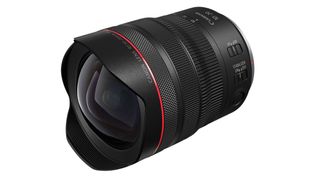Canon’s ultra-wide zoom lens for mirrorless blows its DSLR equivalent out the water
Canon has announced its widest rectilinear zoom lens ever with autofocus, the RF 10-20mm F4 L IS STM, and it looks like a great lens.
Consider the RF 10-20mm – the world’s widest zoom lens with autofocus – as the mirrorless equivalent of the Canon EF 11-24mm f/4L USM for DSLRs, a stable for professional architectural, interior and landscape photographers, but it’s a radically different design that shows what’s possible for mirrorless versus DSLR.
Like the cool 11-24mm F4 DSLR, the RF 10-20mm F4 is a rectilinear ultra-wide angle, meaning straight lines are kept straight throughout the frame rather than barrel distortion, which is a common feature of fisheye and other wide angle lenses. A rectilinear design is a minimum requirement that professional architectural and interior photographers in particular expect from a wide-angle lens, and keeping the lens parallel to your subjects also helps control perspective distortion.
Impressively, the new RF 10-20mm F4 weighs just 570 grams – that’s less than half the weight of the sturdy 11-24mm F4 DSLR, which weighs a whopping 1,180 grams, making it the lightest F4 zoom lens in the world. world becomes. Canon’s lineup. It’s a staggering difference; I can’t think of that much of a contrast between a mirrorless and a DSLR lens design.
Canon RF 10-20mm F4 L IS STM: price and availability
This is Canon and so the RF 10-20mm F4 is obviously pricey. However, the astonishing list price – at least for an F4 lens – is $2,299 / £2579.99 (I’ll update this page with Australian prices as soon as that information becomes available). The lens will be available from October 2023.
Of course, we also get improved image stabilization for mirrorless – combine the 5-stop optical stabilization of the RF 10-20mm with the internal stabilization of an EOS R-series camera and you get up to 6-stops of stabilization. You can throw away the tripod more often, and remember that this lens is also half the weight. Mirrorless for the win.
It is also the first professional L-series lens from Canon to use the STM motors for virtually silent autofocus. That is only possible because this is such a small and light full-frame lens from the L series. The motors keep the focus group in an active position, allowing the RF 10-20mm to start up more quickly from standby.
I haven’t had the lens in my hands yet, but it will no doubt suit an EOS R series camera very well, such as the EOS R5mainly because the heaviest lens elements are placed at the back of the lens instead of the front, which made the front of the EF 11-24mm heavy.
And when you pair the RF 10-20mm with an EOS R5, you get peripheral control over image stabilization – the EOS R5 features the latest algorithms to correct the perspective of the lens for effective stabilization. Usually with ultrawide lenses, flutter in the corners is clearly visible when stabilization kicks in, which can be particularly ugly for video. Other than the EOS R5, we currently don’t know which Canon cameras have or will have peripheral control stabilization.
With a spherical front lens element and built-in lens hood, the 10-20mm F4 lens cannot accept front threaded filters. Instead, however, there is a gelatin filter holder on the back, so you can place the relatively small gelatin filter in there instead.
Analysis: World firsts, for a price
I was a little surprised by the European list price of the RF 10-20mm F4 L STM lens, but this is Canon after all and after reflection it’s a very capable lens that’s in line with comparable ultra-wide zooms.
I expect the optical quality to outperform that of the EF 11-24mm F4 lens when using the F4 aperture, and that the quality difference will be less noticeable at an optimal F11 aperture. We’ll try to test this lens and find out for ourselves. As an L-series lens, we can reasonably expect flare to be well controlled, which is a must for an ultra-wide angle lens that is particularly sensitive to flare.
The fact that Canon has been able to reduce the size and weight significantly – less than half the weight – shows what is possible with Canon’s mirrorless RF mount compared to the aging EF mount. The RF 10-20mm F4 looks like another exciting addition to the EOS R series and will certainly be one of Canon’s best RF lenses, if not one of the best lenses bar none for wide angle landscapes and architecture. Considering the broad perspective in a small package, it could also be an added value for video content creators. Canon fans should be excited about this.

